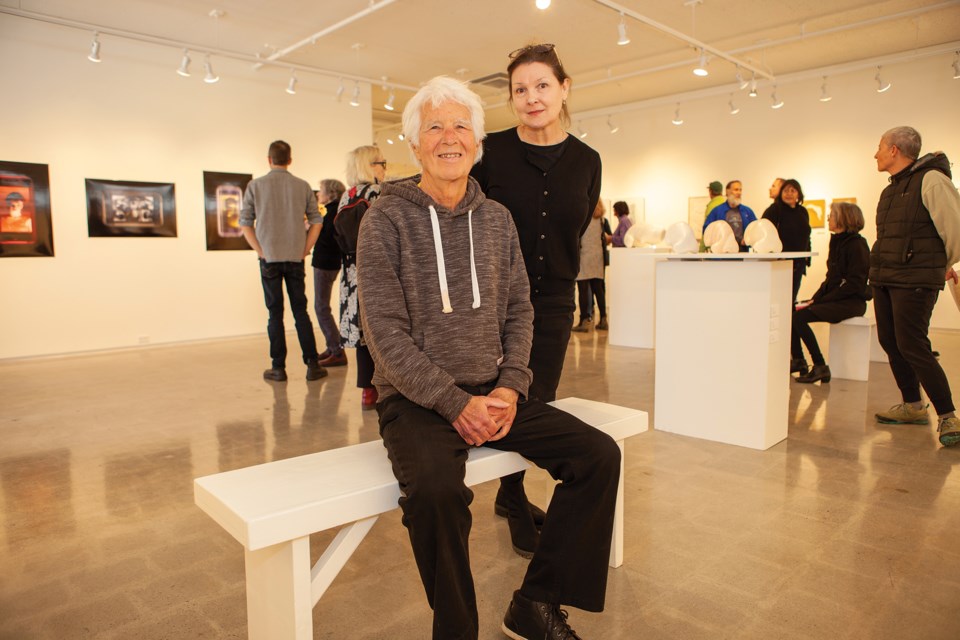Two career artists exhibiting at the Gibsons Public Art Gallery invite empathy by blurring the boundaries of decidedly different magisteria: zoology and digital technology.
At a public reception on April 1, Vancouver-based painter and sculptor Kitty Blandy joined multidisciplinary artist Gordon Halloran, from Roberts Creek, to launch their respective shows before a crowd of more than three dozen supporters.
Blandy’s Finding Animus is her second solo show on the Sunshine Coast, after exhibiting in 2021 with the Sunshine Coast Arts Council. Halloran is a filmmaker, photographer, and maker of monumental artworks whose Shadow Box series consists of large-scale photographic prints.
Blandy’s sophisticated work has been collected by London’s National Portrait Gallery and Lviv’s Ukrainian Independent Museum of Contemporary Art. In this show, elemental studies of animals offer an opportunity to reshape adversarial dialectics.
“I’m interested in being and becoming,” Blandy said. “I think even the word animus is interesting psychologically, because it’s typically used in aggressive, gendered ways. That’s why I wanted to be specific about how I’m using it, which is more about animating spirit, a life force as opposed to an aggression.”
Blandy’s bas-relief works — fashioned from paper and graphite, tinted with tea, or carved from high-density urethane — are arranged in series. In her homologous animal pairing or the nine works of her tetrapods series, rudimentary forms gradually resolve into the physiognomy of familiar animals. Ontogeny recapitulates phylogeny, with each degree of evolutionary complexity prompting a sympathetic response to the animals’ vulnerability.
Her being carvings in marble, alabaster and onyx reduce animal forms to graceful curves and sweeping lines, while reinforcing organic kinship between subjects and their viewers.
“We tend to think of passion as being erotic and consuming,” Blandy said. “But passion originally meant aggression. If you have a passion, you have an animating spirit. Passion isn’t about good or bad. That’s what brings it back to the animals. As humans, we’re always trying to weigh things up as good or bad instead of the fact they just are.”
In contrast, the human subjects of Halloran’s Shadow Box prints — unfocused, discoloured, and framed within the confines of mobile phone screens — invite subjective assessment.
His project began with studio portraits captured in medium-format analogue photography. “Then I thought of cell phone imagery and the sense of being judged through the phone,” Halloran explained. “Using digital software, I started to play with the graphics and the images of the people to get the sense of being isolated and judged by the people who are looking at them.”
Graphics superimposed over the haunted faces — which are by turns tentative, pugnacious and arch — hint at the disposable nature of relationships mediated by Tinder-like swipes.
Halloran’s images conflate the idea of a three-dimensional shadow box (traditionally a case with a transparent front) with more pugilistic themes.
“Shadow boxing can refer to fighting something that doesn’t exist,” he said. “There’s no opponent. That’s what’s going on here. You’ve judged that person, you’ve swiped them, and they’re gone. The box itself — the cell phone — is the shadow box. Everything in it is a shadow.”
The arresting gaze of each subject reinforces their voluntary subjugation to what Halloran calls “the jury box.” Anyone who puts his image into a phone invites voyeuristic appraisal. “People are so used to using those images as some kind of truth,” he added.
Kitty Blandy’s Finding Animus and Gordon Halloran’s Shadow Box remain on display at the Gibsons Public Art Gallery until April 30. Browse to gpag.ca for details.




